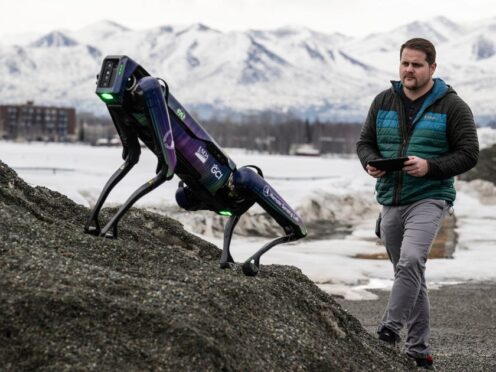
A headless robot about the size of a labrador dog will be camouflaged as a coyote or fox to ward off migratory birds and other wildlife at Alaska’s second largest airport, a state agency has said.
The Alaska Department of Transportation and Public Facilities has named the new robot Aurora and said it will be based at the Fairbanks airport to “enhance and augment safety and operations”, the Anchorage Daily News reported.
The transportation department released a video of the robot climbing rocks, going up stairs and doing something akin to dancing while flashing green lights.
Those dancing skills will be put to use this fall during the migratory bird season when Aurora imitates predator-like movements to keep birds and other wildlife from settling near plane infields.
The plan is to have Aurora patrol an outdoor area near the runway every hour in an attempt to prevent harmful encounters between planes and wildlife, said Ryan Marlow, a programme manager with the transportation department.
The robot can be disguised as a coyote or a fox by changing out replaceable panels, he said.
“The sole purpose of this is to act as a predator and allow for us to invoke that response in wildlife without having to use other means,” Mr Marlow told legislators last week.
The panels would not be hyper-realistic, and Marlow said the agency decided against using animal fur to make sure Aurora remained waterproof.
The idea of using a robot came after officials rejected a plan to use flying drones spraying a repellent including grape juice.
Previous deterrent efforts have included officials releasing pigs at a lake near the Anchorage airport in the 1990s, with the hope they would eat waterfowl eggs near plane landing areas.
The test period in Fairbanks will also see how effective of a deterrent Aurora would be with larger animals and to see how moose and bears would respond to the robot, Mr Marlow told the Anchorage.
Fairbanks “is leading the country with wildlife mitigation through the use of Aurora. Several airports across the country have implemented robots for various tasks such as cleaning, security patrols, and customer service,” agency spokesperson Danielle Tessen said in an email to the Associated Press.
In Alaska, wildlife service teams currently are used to scare birds and other wildlife away from runways with loud sounds, sometimes made with paintball guns.
Last year, there were 92 animal strikes near airports across Alaska, including 10 in Fairbanks, according to an Federal Aviation Administration database.
Most strikes resulted in no damage to the aircraft, but Marlow said the encounters can be expensive and dangerous in the rare instance when a bird is sucked into an engine, potentially causing a crash.
An AWACS jet crashed in 1995 when it hit a flock of geese, killing 24 people at Elmendorf Air Force Base in Anchorage.
If the test proves successful, Mr Marlow said the agency could send similar robots to smaller airports in Alaska, which could be more cost effective than hiring human deterrent teams.
Aurora, which can be controlled from a table, computer or on an automated schedule, will always have a human handler with it, he said. It can navigate through rain or snow.
The robot from Boston Dynamics cost about 70,000 US dollars (£55,000) and was paid for with a federal grant.

Enjoy the convenience of having The Sunday Post delivered as a digital ePaper straight to your smartphone, tablet or computer.
Subscribe for only £5.49 a month and enjoy all the benefits of the printed paper as a digital replica.
Subscribe